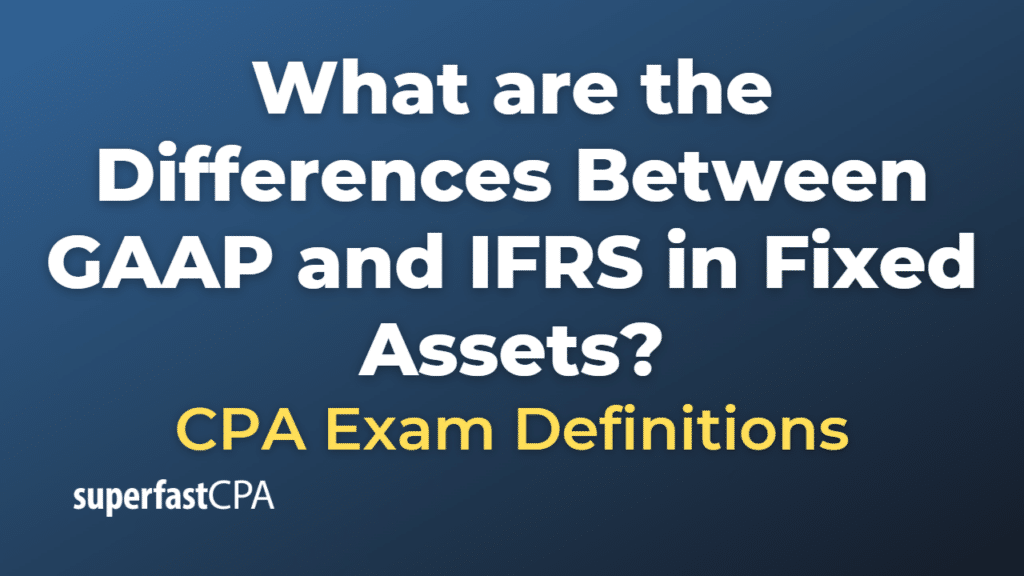Differences Between GAAP and IFRS in Fixed Assets
GAAP (Generally Accepted Accounting Principles) and IFRS (International Financial Reporting Standards) are two frameworks that companies use for preparing financial statements. They differ in a few significant ways when it comes to accounting for fixed assets (also known as Property, Plant, and Equipment – PP&E).
- Component Depreciation: Under IFRS, component depreciation is required if different parts of an item have different useful lives. For example, the engine of an aircraft may need to be replaced before the aircraft itself. In this case, the engine and the aircraft would be treated as separate components, each with its own depreciation schedule. Under GAAP, component depreciation is allowed but not required.
- Revaluation: IFRS allows companies to revalue their fixed assets to fair market value if fair value can be measured reliably. Any increase in an asset’s value can be credited to equity under ‘revaluation surplus’ until the asset is disposed of or derecognized. GAAP, on the other hand, does not generally permit revaluation of fixed assets to fair values.
- Impairment : Both GAAP and IFRS require companies to review their fixed assets for impairment (when an asset’s market value falls below its book value), but the methods they use are different. IFRS uses a one-step process for impairment testing (comparing carrying value to the higher of fair value less costs to sell and value in use, which is discounted future cash flows), resulting in a potentially earlier recognition of impairment losses. GAAP uses a two-step process that first compares the carrying value with undiscounted future cash flows, then measures the impairment as the amount by which the carrying value exceeds the fair value of the asset.
- Cost Model : Both GAAP and IFRS allow for the use of the cost model (where an asset is carried at cost less accumulated depreciation and any accumulated impairment losses) for subsequent measurement. However, as noted earlier, IFRS also permits the revaluation model.
- Investment Property: IFRS has specific guidelines for investment property (property held for capital appreciation or rental income), which can be measured using either the cost model or the fair value model. Changes in fair value are recognized in profit or loss. Under GAAP , investment properties are accounted for as a part of PP&E and subject to depreciation.
The choice between GAAP and IFRS can have a significant impact on how a company’s financial condition is represented. It’s important to understand these differences when comparing companies that use different accounting frameworks.
Example of the Differences Between GAAP and IFRS in Fixed Assets
Let’s use an example of a manufacturing company that owns a factory to illustrate the differences between GAAP and IFRS in relation to fixed assets.
1. Component Depreciation:
Under IFRS, if the factory’s roof and machinery have different useful lives, the company would need to depreciate these components separately. So if the machinery has a useful life of 10 years and the roof 20 years, they would calculate depreciation separately for each component.
Under GAAP, the company could choose to do the same, but it’s not a requirement. They could also depreciate the whole factory over a single useful life (determined by weighting the different components), say, 15 years.
2. Revaluation:
Five years down the line, the value of the factory (due to market conditions) increases significantly. Under IFRS, the company can revalue the factory to this higher fair market value on their financial statements.
Under GAAP, this revaluation is generally not allowed. The factory would remain on the books at its historical cost, less any accumulated depreciation.
3. Impairment:
If, a few years later, the local area’s economic condition deteriorates, and the factory’s market value falls below its book value, both GAAP and IFRS would require an impairment test. However, the processes would differ.
Under IFRS, the company compares the factory’s carrying value directly to its recoverable amount (the higher of its fair value less costs to sell and its value in use, which is the present value of future cash flows). If the carrying value is higher, an impairment loss is recognized.
Under GAAP, the process is two-step. First, the company compares the carrying value with the estimated future cash flows from the factory (not discounted). If the future cash flows are less than the carrying value, then a second step is conducted to measure the impairment loss, which is the amount by which the carrying value exceeds the fair value of the factory.
4. Cost Model and Investment Property:
Finally, let’s say the company buys another property as an investment, intending to rent it out. Under IFRS, this investment property can be reported at fair value, with changes in fair value recognized in profit or loss. It also can be reported using the cost model.
Under GAAP, however, this investment property is treated as PP&E and depreciated, with the fair value model not being an option.
These examples show how the treatment of the same assets can differ significantly under GAAP and IFRS.













